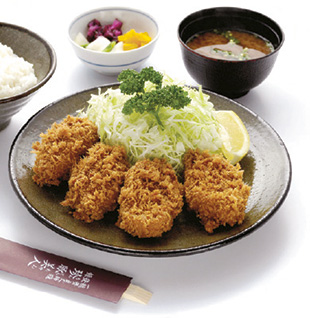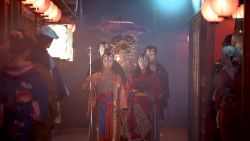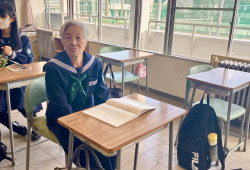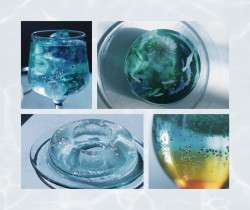
Originally published on metropolis.co.jp on October 2013
A perfectly prepared tonkatsu—a thick, juicy pork cutlet enrobed in a golden crust of crisp breadcrumbs—is a thing of beauty. Achieving such perfection, though, is not easy. The cutlet must be properly sourced and sized. The oil must be fresh and kept at the exact scalding temperature. And the flake size of the crumbs must be carefully considered.
The dredging in flour, beaten egg and breadcrumbs must be done quickly and expertly. The chef must then keep a wary eye on the frying process, watching the changing hue of the coating, the size and rate of the rising steam-filled bubbles, their sound and the buoyancy of the frying katsu.
A tonkatsu meal will always include a small mound of finely shredded cabbage, and some type of tangy Worcestershire-based sauce handy on the table. If you spring for a teishoku set menu, you’ll get a bowl of rice, a bowl of miso or tonjiru (pork broth) soup, and a small dish of pickles.
In the restaurants that take pride in their work, the cabbage filaments are cut by hand, the pickles are house-made and so is the soup.
If you’re looking for pork heaven, never mind that former bathhouse place that’s in all the guidebooks. Search out one (or all) of these establishments chosen from our favorite tonkatsu places across the city.
Bairin

Bairin in Ginza started serving tonkatsu in 1927. And its 200-gram kurobuta (Berkshire pig) cutlet is two centimeters of tender luscious goodness. This rosu (loin) cut includes a thin strip of tasty melt-in-your-mouth fat beneath the crisp breading. Unusually—and aesthetically pleasing—the mound of sweet cabbage includes dark green filaments from the outer leaves.
The handiwork at Bairin runs as smooth as a fine pocket watch. In a row behind the long counter stand four white uniformed cooks each precisely doing his appointed task: frying, cutting, preparing side orders and ladling out soup and rice. Another cook in the kitchen provides the fresh cabbage—a constant staccato of knife chopping.
Though a bit pricey, the ¥2,700 rosu katsu teishoku is very well worth it. The house-made sauce at Bairin is especially toothsome.
7-8-1 Ginza, Chuo-ku. Tel: 03-3571-0350. Open Mon-Fri 11:30am-8:45pm. Nearest stn: Ginza. www.ginzabairin.com
Sugita

Worth a trip to Kuramae, one stop from Asakusa, is Sugita. This nicely designed restaurant with its second-generation chef and gleaming copper pots serves a tonkatsu (¥2,000) with a bread crumb as fine as sand—which makes an especially crispy crust. Of course, they also have their own specially blended sauce.
3-8-3 Kotobuki, Taito-ku. Tel: 03-3844-5529. Open 11:30am-2pm & 5-8:30pm, closed Thu. Nearest stn: Kuramae.
Maru-ichi

A few minutes from JR Omori station, Maru-ichi is a tiny place with only a seven-seat counter and two tables each seating four. The menu is small, too. All orders are teishoku sets. You can choose either the lean hire (fillet) or the succulent rosu each at several weights: 170 grams, 250 grams or, for the genuine trencherman, the 300-gram plate.
All the ingredients at Maru-ichi are carefully sourced. The pearly pink cutlets come from Iwate. The red-orange carrots are grown in Chiba and the surprisingly sweet cabbages are harvested in the Miura peninsula.
Compared to other tonkatsu joints, the rice is softer and more delicious; the carrots and cabbage sweeter; the meat more tender and flavorful. This is due to the great care that goes into everything at Maru-ichi. They go to the trouble, for example, of boiling the carrots, burdock, and onions separately to make sure they are evenly tender before adding them to the pork-based miso soup to make their tonjiru.
Don’t mind the drab exterior of Maru-ichi. The interior is spotlessly clean and all efforts at beauty are focused on the plate.
1-7-2 Omori Kita, Ota-ku. Tel: 03-3762-2601. Open 11:30am-1pm & 5-7pm, closed Wed, Sun and hols. Nearest stn: Omori.
Marugo

A few minutes walk from Akihabara station, Marugo is another tonkatsu connoisseur destination. It features sangenton pork from Yamagata Prefecture. This crossbreed animal is a mix of Yorkshire, Landrace and Duroc hogs that results in a fine balance of flavor and lacy marbling in the flesh. The rosu (¥1,750 yen) is three centimeters thick, terrifically juicy and tender plus there is a special dressing for the cabbage.
1-8-14 Soto Kanda, Chiyoda-ku. Tel: 03-3255-6595. Lunch 11:30am-2:50pm & 5-8:20pm, closed Mon and third Tue. Nearest stn: Akihabara.
Yamaichi

The folks at Yamaichi in Kanda Sudacho serve a tonkatsu that is thicker than at most other joints. It is expertly trimmed, weighed and coated with a larger size of breadcrumb. too. The teishoku sets feature a reasonably priced hire (¥1,600) or the rosu (¥1,500) with its strip of delicious fat nestled in unctuousness under the crust.
This establishment believes in condiments. On the table is a panoply of 11 various additions to choose from such as Andes salt, yuzu kosho (citrus and pepper), shichimi (blend of seven spices), two kinds of shoyu, pickled scallions, mustard, two kinds of salad dressing, sesame, ponzu (citrus and soy) sauce, umeboshi (dried plum) and Bull Dog sauce.
Yamaichi is decorated with some style. The tables are dark, gleaming grainy wood. Framed modern lithographs hang on the wall. Don’t worry about the line that usually forms outside the restaurant. It moves quickly and you’ll soon be inside.
1-8-4 Kanda Sudacho, Chiyoda-ku. Tel: 03-3253-3335. Open Mon-Fri 11am-2:30pm & 5-8:30pm, Sat 11am-2pm, closed Sun and hols. Nearest stn: Kanda.







